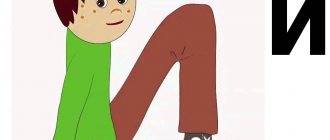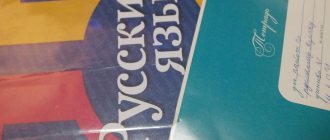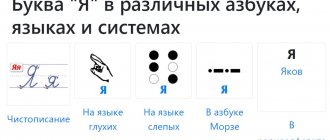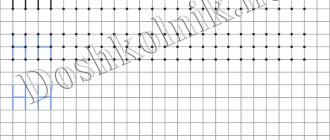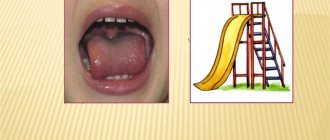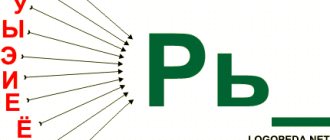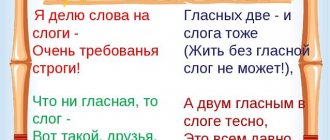Learning to read syllables - this stage in teaching children to read is one of the most important and difficult. Often parents simply don’t know how to teach their child to pronounce two letters together and get “stuck” on this for a long time. Tired of the endless repetition of “ME and A will be MA,” the child quickly loses interest, and learning to read turns into torture for the whole family. As a result, children who already know letters from the age of two or three, even by the age of five cannot read simple words, not to mention reading sentences and books.
What to do next when the child remembers the letters? Let’s immediately make a reservation that teaching a preschooler to read syllables can begin BEFORE he has mastered the entire alphabet (moreover, some teachers insist that you need to move on to syllables as quickly as possible, without waiting for all the letters to be learned). But the child must name the letters that we will combine into syllables without hesitation.
In order to begin learning to read syllables, a child only needs to know 3-4 vowels and several consonants. First of all, take those consonants that can be drawn out (S, Z, L, M, N, V, F), this will help teach the child how to pronounce the syllable together. And this is a fundamentally important point.
So, let's look at several, in our opinion, the most effective methods that modern teachers offer for teaching a child to form letters into syllables.
Let's play "Trains"
(game from the manual by E. Baranova, O. Razumovskaya “How to teach your child to read”).
Instead of boring cramming, invite your child to “ride the train.” All the consonants are written on the rails on which our trailers will travel, and the vowels are written on the trailers themselves. We place the trailer on the rails so that a consonant appears in the window, and name what station we have (for example, BA). Next, we move the trailer down the rails until the next consonant and read the syllable that appears.
There is a similar manual in the cards “Train Engine Game”. We read the syllables." from E. Sataeva
This game is good because the child does not need to be specifically explained how to add syllables. It is enough to say: “Now we will ride the letter A, it will be our passenger, name all the stations where we will stop.” First, “take a ride” yourself - let the child move the trailer along the rails, and you loudly and clearly call the “stations”: BA, VA, GA, DA, ZHA, ZA, etc. Then invite your child to do this with you in turn. During the game, listening to you, children easily grasp how to pronounce two sounds together. The third time, the child can “ride” himself without much difficulty.
If the child does not know all the letters, stop only at those “stations” that are familiar to him. Next we change the trailer. Now we roll the letters O, U, Y. If the child copes with the task easily, we complicate the task. For example, we go for a speed ride, timing which of the trailers will get to the end of the journey first. Or another option: when stopping at a station, the child must name not only the syllable, but also the words starting with this syllable (BO - barrel, side, Borya; VO - wolf, air, eight; GO - city, golf, guests; DO - rain, daughter, boards, etc.).
Please note that with this game you can practice reading not only open syllables (with a vowel at the end), but also closed ones (with a consonant at the end).
To do this, we take the trailers where the vowels are written in front of the window, and proceed in the same way. Now we have a letter on the trailer, not the passenger, but the driver, she is the main one, she is in front. First, read the resulting “stations” with closed syllables yourself: AB, AB, AG, AD, AZ, AZ, etc., then offer the child a “ride.”
Remember that in this and other exercises we first practice adding syllables with vowels of the first row (A, O, E, U, Y), and then introduce vowels of the second row (Ya, Yo, E, Yu, I) - so-called “iotated” vowels, which make the sound preceding them soft.
When the child is good at reading individual tracks with syllables, alternate the carriages with passengers and drivers, without telling which carriage we will be rolling. This will help the child learn to clearly see where exactly the vowel is in a syllable (the syllable begins or ends with it). At the first stages of learning to read syllables, a child may have difficulties with this.
How to understand when it's time
To the question “When is it time for a child to learn to read?” There is no ready answer, but we would like to immediately warn against two misconceptions:
- “You don’t have to teach your child to read at home; they will teach you at school anyway.” Alas, they won’t teach - school teachers simply don’t have time to teach every child to read correctly. Already in the first lessons you will have to read books, textbooks, and inscriptions on the board. Not being able to read, a first-grader risks immediately falling behind his classmates and losing interest in learning.
- “There is no time to waste - the sooner the baby starts reading, the better.” All children are different and develop at their own pace. Therefore, you should not impose learning to read on a preschooler as soon as he is 4–5 years old, if the student himself does not yet show interest in this activity.
The indicator that you should focus on is not the age of the preschooler, but his speech skills.
It's time to learn to read if...
If a preschooler has already developed a sufficient vocabulary to chat with adults, if he constructs sentences grammatically correctly, understands and uses phraseological units in his speech, then the child is ready to learn to read.
Without a sufficient grammatical foundation and vocabulary, learning to read will be difficult. It is critical that the child understands the meaning of the words and phrases he reads, otherwise learning will not be productive. Therefore, if the child is not yet very confident in speaking, do not rush him into reading - this will not help develop speech, but will only demotivate him.
“Running” from one letter to another
(from “The ABC for Kids” by O. Zhukova)
This is a visual exercise that will help a child learn to pronounce two letters together.
Before us is a path from one letter to another. To overcome it, you need to pull the first letter until the finger we move along the path reaches the second letter. The main thing we are working on in this exercise is so that there is no pause between the first and second sound. To make it more interesting to practice, replace your finger with a figurine of any animal/person - let it run along the path and connect two letters.
Preparatory stage
Undoubtedly, it is difficult to try to explain something to a one-year-old baby and teach him to pronounce words or parts of them, although it is possible. According to the latest research, experts believe that some children can start learning simple words and connecting syllables as early as 2 or 3 years old.
However, at such an early age you should not overload children with information that is unnecessary for them, but devote more to the preparatory stage: help the baby develop phonemic awareness and learn letters.
The development of phonemic hearing is facilitated by reading and memorizing nursery rhymes, short poems and songs.
It is better to study letters in a playful way.
Creative tricks for memorizing letters:
- Trace, color, shade letters with pencils.
- Sculpt letters from plasticine and kinetic sand.
- Lay out letters from sticks, mosaics, cubes.
Techniques for memorizing letters for preschoolers: modeling with plasticine
Games with letters that are friends
(“A Primer for Kids” by E. Bakhtina, “Russian ABC” by O. Zhukova, etc.).
Many authors of primers and alphabet books use animated images of letters that need to be put into a syllable - they are friends, walk together in pairs, pull each other through obstacles. The main thing in such tasks, as in the previous exercise, is to name two letters together so that the two companion letters remain together.
To use this technique, you don’t even need special manuals or primers. Print out several figures of boys and girls (animals, fairy-tale or fictional characters), write a letter on each of them. Let consonants be written on the boys' figures, and vowels on the girls' figures. Make friends with the children. Check with your child that boys and girls or two girls can be friends, but making two boys friends (saying two consonants together) is not possible. Change pairs, put girls first in them, and then boys.
Read the syllables first in one order, then in the reverse order.
These few techniques are quite enough to teach a child to add two letters into a syllable. And learning in the form of a game will allow you to avoid cramming and boring repetition of the same thing.
Exercises
- Reading "Tug"
The baby reads after the parent in a low voice, 1-2 syllables or words behind. The pace increases gradually.
- Divide into syllables
The game is played orally or in writing. Start with simple words, gradually move on to more complex ones.
- Let's catch up with the letter
M………., A, S…………….O The baby should pull his finger along the path, pronouncing sounds.
- How the letters became friends
Draw letters and pull their handles towards each other. You can use simple arithmetic schemes C+O=CO.
- What's extra?
From the words written syllable by syllable on the sheet, you need to cross out the unnecessary. For example, apple, pear, tomato.
Games for strengthening the skill of adding letters
Next, we move on to consolidating this skill and reading simple words. Various games with syllables will help you strengthen the skill of adding letters into syllables, such as:
— Syllabic lotto
It’s very easy to make them yourself; to do this, you need to select several pictures - 6 for each card and print out the corresponding syllables.
- The manual “Syllables” will help you. Choose a picture based on the first syllable BA-, BA-, MA-, SA-, TA-. Educational lotto games. Federal State Educational Standards Before" by E. V. Vasilyeva - there are several more manuals in this series
- Game “Letters, syllables and words. Lotto with verification" by A. Anikushena
- Similar exercises are in the book “Syllable Tables. Federal State Educational Standard" N. Neshchaeva
— Shop game
Place toy products or pictures with their images on the counter (for example, FISH-ba, DY-nya, PI-horns, BU-lka, YAB-loki, MYA-so). Prepare “money” - pieces of paper with the name of the first syllables of these words. A child can buy goods only with those “bills” on which the correct syllable is written.
— Albums with syllables
Make an album with your own hands with your child, in which a syllable will be written on one page of the spread, and on the other - objects whose names begin with this syllable. Periodically review and add to these albums. For more effective learning to read, close either one or the other half of the spread (so that the child does not have unnecessary clues when naming a syllable or selecting words for a certain syllable).
“Cards for sound and syllabic analysis of words” will help you with this.
— Airfield game (garages)
We write the syllables large on sheets of paper and lay them out around the room. These will be different airfields (garages) in our game. The child takes a toy plane (car), and the adult commands which airfield (in which garage) the plane should be landed (the car parked).
— Paths of syllables
Zaitsev's cubes or any cards with syllables (you can make them in the form of traces) are suitable for this exercise. We build a long path from them - from one end of the room to the other. We choose two figures/toys. You play one, the child plays the other. Roll the dice - take turns with your figures on the cards for as many moves as the number rolled on the dice. As you step on each card, say the syllable written on it.
For this game you can also use various “adventures” by writing syllables in circles on the playing field.
Books
During the homeschooling process, parents will need methodological support. To do this, you can use the following manuals:
- O. Uzorova “Quick learning to read.”
- N. S. Zhukova “Primer”.
- I. Brodsky “Working ABC”.
- G. R. Lazgdyn “Speech therapy alphabet”.
- Kozhevnikova A. Yu. “Battlers.”
- Teacher's aids from the set for Zaitsev's cubes and Doman's cards.
First sentence
Learning to read is almost complete, and if everything goes correctly, the baby will be able to read his first sentence without difficulty. It should be simple and understandable, for example: “Inna washed the frame,” and you can read a short sentence even before all the sounds are learned, the main thing is that the selected piece contains only syllables familiar to the baby.
As a rule, this stage passes quickly and cheerfully, the child likes what he can read, children begin to practice with pleasure and often, thanks to their linguistic intuition and amazing memory, read even those letters that have not yet been studied with their parents.
This is a step-by-step program for learning to read in preschool age. If mom and dad were patient and gentle and praised their baby, then home lessons were easy and fun, so success would please both. Training should be carried out regularly, but not take a lot of time - it is necessary to stop even before the baby gets tired, be sure to inform him that tomorrow he will be introduced to even more interesting information, then he will look forward to the next lesson.
Tips for parents
Start learning with sounds, not letters. Otherwise the child will get confused.
Eliminate any negative emotions during the learning process. They scare the child and discourage learning.
For many children, the words “study” and “lessons” cause protest. Conduct classes in a playful way so that the child has fun and, most importantly, interesting.
No need to force. Learn to negotiate. For example, suggest playing letters first and then going to the park.
Where can I get cards with texts for preschoolers?
You can make cards yourself or find age-appropriate ones on the Internet. If we make cards ourselves, then we can make sentences in such a way that they tell about the child himself.
Even write down his name. This will definitely interest the young reader, and he will want to know what is written about him.
The text in sentences should be made large and bold. This will facilitate visual perception of information. At the first stages, a hyphen is placed between the syllables, which will also make reading easier, because the baby is already familiar with the syllables.
Basic techniques
There are several methods that allow you to teach a child to read; we present the pros and cons of each of them in the form of a table.
| Method name | Short description | Advantages | Flaws |
| Sound (phonetic) | Children learn to pronounce words and sounds and begin reading when they remember enough phonemes to read their first words. | Used at school, so the baby will be saved from having to relearn. Eliminates speech defects, teaches you not only to read correctly, but also to pronounce words. You can exercise anytime, anywhere. | Requires a long time, training will be long. At first, the baby will be so focused on the process of correctly pronouncing phonemes that he will not understand the meaning of what he read. |
| Zaitsev cubes | Learning to read by sequences (a sequence is the pair “consonant + vowel, or consonant + b, b). | Learning through games will be fun for both children and adults. The child learns to read quickly, with joy, and does not suffer from performing a boring and obscure action. The system is not tied to a specific age; it can be used at least one year old, at least 5-6 years old. | At school, children will be retrained, since they will teach phonemic analysis of a word, and not dividing it into words. Some problems may arise with the letter E: on the cubes there are many variants such as “BE”, “DE”, but in the Russian language there are very few words of this kind. |
| Doman cards | Recognition of a whole word - without dividing it into component parts. Rather, not reading, but memorizing and reproducing. The child quickly makes progress thanks to his amazingly flexible memory, and gradually he develops an understanding of the principles of reading a particular group of letters. | Memory development, the ability to teach reading from an early age. | Preliminary preparation is required (make a lot of neat cards), regularity of classes. Cards with specific words should be shown to the baby several times a day, taking into account his individual pace of perception of information. Often children taught in this way learn to read situationally, unable to read, for example, a familiar word, but printed in a different font. |
| Maria Montessori Method | First, children learn to write (frames-contours are used for this), only after that they become familiar with letters. | The classes are fun and not boring, children learn to read and write at the same time, and during the reading process they do not divide the word into syllables, reading it completely. The activities also help develop fine motor skills. | The technique is intended for work in a kindergarten group, and not at home. You will need a large amount of didactic material that will have to be purchased. |
| Olga Soboleva's program | It is built according to the method of letter recognition and is aimed at the creative development of the baby. There is practically no mechanical memorization; the work is based on associations. | Children have fun and learn to love reading. The technique helps you learn a lot of new words and not give in to a new type of activity, and feel free to use a creative approach. | Suitable for creative kids and their equally creative parents. There is no clear description of what should be done and how, so you need to use your imagination. |
Each of the considered methods has both pros and cons, so parents will have to choose the elements of each of them that best suit the characteristics of their baby, and use them in daily, targeted work. There are several interesting activities that parents can use at different stages of learning to read.
Reading by syllables
From the earliest years, a person is surrounded by letters everywhere. Texts of books, signs on stores, messages on a mobile phone - it is difficult to imagine at least one day when there is no need to read something. For schoolchildren, text processing skills are no less important than for adults. How well a student perceives information from textbooks and various aids directly determines his or her performance at school. This is why it is so important to prepare children for school in the lower grades in advance.
Learning letters and sounds is usually not difficult if you spend time practicing every day. But for children who begin to read words syllable by syllable, it is not easy to master this stage of learning. This is largely due to the lack of a clear training plan that would allow one to acquire new skills and properly consolidate them. So it turns out that no matter how much parents try to read words for children syllable by syllable, children do not always manage to master this skill themselves.
Of course, it is worth differentiating the knowledge requirements for children of different ages. Depending on whether your child has started school or is still attending kindergarten, you need to approach activities with him differently. Let's take a closer look at the main recommendations for parents of preschoolers and elementary school students.
Positive experience
Emotionally developed, full of impressions, preschoolers quickly gain positive learning experiences. Additional incentive in the form of praise and support helps children self-motivate for educational activities.
Thanks to the rapid development of memory, attention, and mental operations, five to seven-year-old preschoolers are already able to receive and process a large flow of information. But this should not be abused. Still, this is a child’s brain, and the dose of information should be calculated specifically for the child’s age stage and the corresponding cognitive experience of the child.
